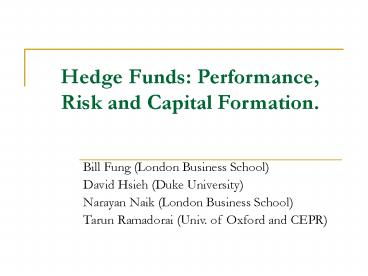Hedge Funds: Performance, Risk and Capital Formation. - PowerPoint PPT Presentation
Title:
Hedge Funds: Performance, Risk and Capital Formation.
Description:
Managers have differential ability to generate high returns, but face decreasing ... Investors learn about managerial ability from past performance and direct more ... – PowerPoint PPT presentation
Number of Views:165
Avg rating:3.0/5.0
Title: Hedge Funds: Performance, Risk and Capital Formation.
1
Hedge Funds Performance, Risk and Capital
Formation.
- Bill Fung (London Business School)
- David Hsieh (Duke University)
- Narayan Naik (London Business School)
- Tarun Ramadorai (Univ. of Oxford and CEPR)
2
Focus of this paper
- What is the relationship between risk-adjusted
performance (alpha), alpha persistence, and
capital formation in the hedge fund industry? - Testing whether Berk and Greens (JPE 2004)
rational model of active portfolio management is
appropriate for the hedge fund industry.
3
The Berk and Green Model
- Berk and Green (JPE 2004) Rational model of
active portfolio management has three features - Investors competitively provide capital to funds.
- Managers have differential ability to generate
high returns, but face decreasing returns to
scale in deploying their ability. - Investors learn about managerial ability from
past performance and direct more capital towards
funds with superior risk-adjusted performance. - Results in zero alpha and zero alpha persistence
in equilibrium.
4
Preview of our main conclusions
- Implication 1 of Berk and Green Funds with
higher ability managers should experience greater
capital inflows . - We show that funds that generate statistically
positive alpha experience far greater and
steadier capital inflows than their less
fortunate counterparts.
5
Preview of our main conclusions
- Implication 2 of Berk and Green Diminishing
returns to scale combined with the inflow of new
capital leads to erosion of superior performance
over time, even for high ability funds. - We show that capital inflows lead to lower alpha,
and lower alpha persistence. - We provide evidence that even alpha-producing
funds have experienced a recent, dramatic decline
in risk-adjusted performance.
6
A Few Facts About Hedge Fund Returns
- Individual hedge fund data is subject to biases
- Fung and Hsieh (2000) and Liang (2000)
- Hedge funds exhibit different styles/systematic
risk. - Fung and Hsieh (1997, 2001, 2002, 2004),
Brown and Goetzmann (2003), Mitchell and Pulvino
(2001), Agarwal and Naik (2004) etc - Hedge fund performance measurement is hard
because of illiquidity in their holdings. - Getmansky, Lo, Makarov (2004), Asness, Krail
and Lew (2001) - The best (and worst) hedge funds exhibit
statistically detectable performance persistence. - Kosowski, Naik and Teo (2005), Jagannathan,
Malakhov and Novikov (2006) - And much more interesting research that I have
little time to mention today!
7
The Data
- Consolidate data from CSFB/Tremont TASS, HFR and
CISDM. The most comprehensive set of Funds of
Hedge Funds that is publicly available - 1603 in
total. - Ten-year period (Jan 1995 to Dec 2004).
Breakpoints in the data confirmed by the Chow
test. - Period I January 1995 to September 1998.
- Period II October 1998 to March 2000.
- Period III April 2000 to December 2004.
- We use the Fung-Hsieh seven-factor model to
estimate alpha and find
8
For the Average FoF No Detectable Alpha Except
in Period II (October 1998-March 2000) see
Table II
9
Differentiating Funds on Alpha Production
- For each two-year period, do the Kosowski,
Timmerman, White and Wermers (2006) bootstrap. - Basic intuition trying to avoid Type I errors in
detecting funds with alpha. - OLS t-stat is misleading if errors are
non-normally distributed and non i.i.d. - This is very likely a problem for FoF returns.
- Robustness check the results in a variety of
ways. - Getmansky-Lo-Makarov (2004) correction.
- Politis-Romano (1994) stationary bootstrap.
10
Have Alphas and Have Betas see Table III
11
Have Alphas and Have Betas Transitions see
Table III
12
Have Alpha, Have Beta Liquidations Table IV
13
Do Investors Recognize Differences Between Have
Alphas and the Rest? Yes! See
Figure 1
14
Differences in Flows see Table V
15
Do The Flows Behave Differently?
- Are our results driven by total return-chasing
rather than alpha-perception on the part of
investors? - Perhaps there are clientele differences between
have alphas and the rest? - Regress quarterly flows on past quarters returns
and past quarters flows.
16
Do The Flows Behave Differently? see Table VI
- Perhaps there are clientele differences between
have alphas and have betas?
17
Do the Flows Generate Declines in Alpha?
- First, condition two-year transition
probabilities, t-stat of alpha and magnitude of
alpha on level of flow (above median or below
median flow). - Second, identify time-variation in alpha for have
alphas and have betas, to check if there are
corresponding trends.
18
Do Flows Generate Declines in Alpha? Results
for Have Alphas see Table IX
- Same is true for the t-stat of alpha and
magnitude of alpha, see Table XI
19
Do Flows Generate Declines in Alpha? Results
for Have Betas see Table X
- No detectable difference on t-stat and
magnitude of alpha (see Table XII), but recall
these are beta-only funds anyway.
20
Has the Alpha Generating Ability of Alpha
Producers Changed Over Time? See Table XIII
21
Conclusions
- Consistent with Berk and Green (JPE 2004), there
are significant differences in the ability of
managers to deliver alpha. - Investors appear to perceive these ability
differentials, and direct a steady stream of
capital to the managers with higher ability. - The persistent inflow of capital is associated
with a decline in the alpha produced in the hedge
fund industry. - The decline is experienced by all managers
regardless of ability.
22
Question?
- Recall that Berk and Greens model predicts zero
alpha and zero alpha persistence in equilibrium - Is the hedge fund industry heading that way?































